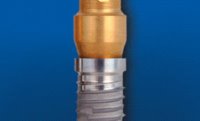Is it possiblly exist "platform switching" in dental implant-abutment
 Dental Implant Abutments
Dental Implant AbutmentsThe other day, we were looking at a case from another office, and wondering why the abutments were much smaller, or stepped back from the dental implant itself.
This was quite an old case , so we know that this was not intentional. But what was so interesting was that there was no bone loss in this case. There are other recent studies that have shown no bone loss with an abutment that was step backed from the implant itself. What does that tell us? Some manufacturers have already been offering these types of abutments for quite some time. Is this the future direction for abutments? Feel free to add your feedback below.
Discussion on OsseoNews:
http://osseonews.blogs.com/osseodaily/2005/10/dental_implant_.html#c20678445
Platform switching: a new concept in implant dentistry for controlling postrestorative crestal bone levels.
Histologic and radiographic observations suggest that a biologic dimension of hard and soft tissues exists around dental implants and extends apically from the implant-abutment interface. Radiographic evidence of the development of the biologic dimension can be demonstrated by the vertical repositioning of crestal bone and the subsequent soft tissue attachment to the implant that occurs when an implant is uncovered and exposed to the oral environment and matching-diameter restorative components are attached. Historically, two-piece dental implant systems have been restored with prosthetic components that locate the interface between the implant and the attached component element at the outer edge of the implant platform. In 1991, Implant Innovations introduced wide-diameter implants with matching wide-diameter platforms. When introduced, however, matching-diameter prosthetic components were not available, and many of the early 5.0- and 6.0-mm-wide implants received "standard"-diameter (4.1-mm) healing abutments and were restored with "standard"-diameter (4.1-mm) prosthetic components. Long-term radiographic follow-up of these "platform-switched" restored wide-diameter dental implants has demonstrated a smaller than expected vertical change in the crestal bone height around these implants than is typically observed around implants restored conventionally with prosthetic components of matching diameters. This radiographic observation suggests that the resulting postrestorative biologic process resulting in the loss of crestal bone height is altered when the outer edge of the implant-abutment interface is horizontally repositioned inwardly and away from the outer edge of the implant platform. This article introduces the concept of platform switching and provides a foundation for future development of the biologic understanding of the observed radiographic findings and clinical rationale for this technique.
Int J Periodontics Restorative Dent. 2006 Feb;26(1):9-17. Lazzara RJ, Porter SS

